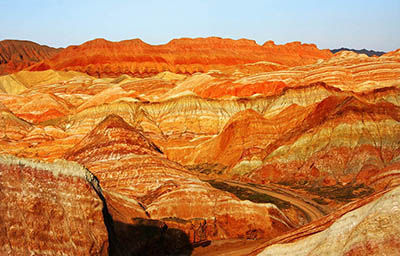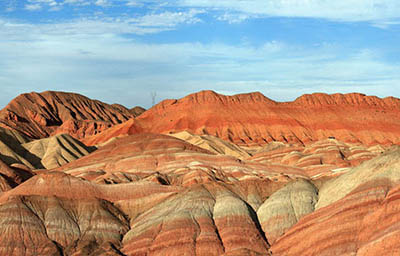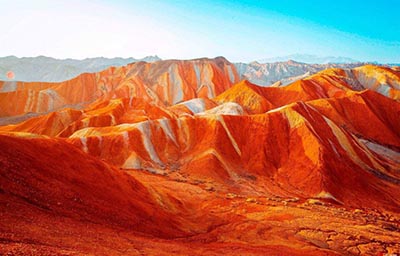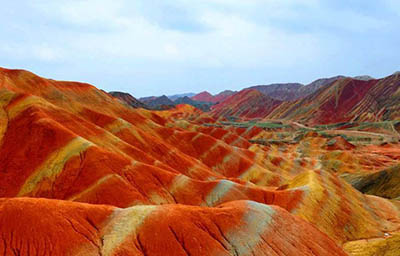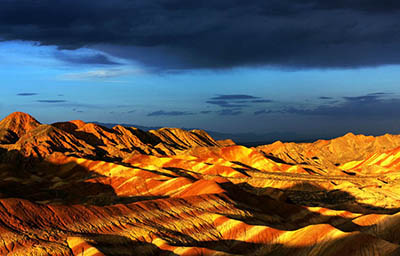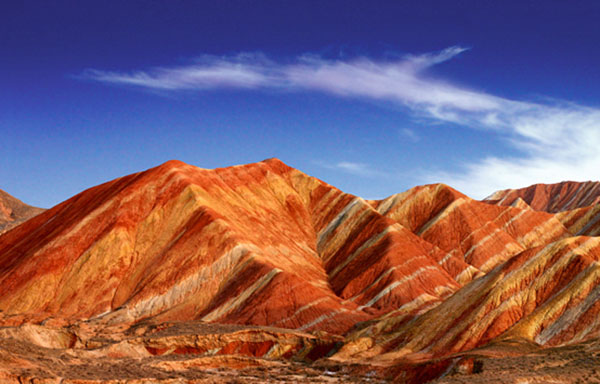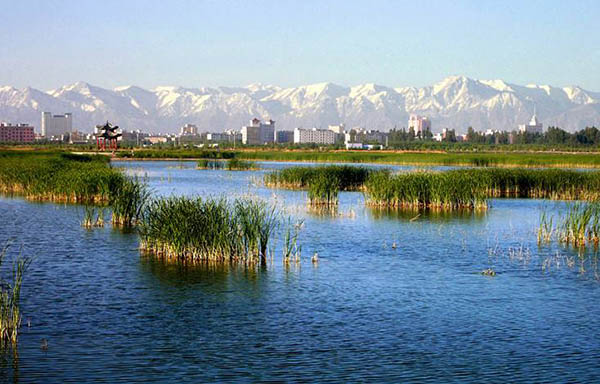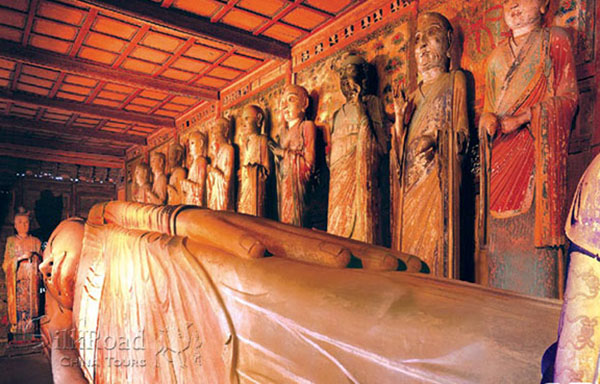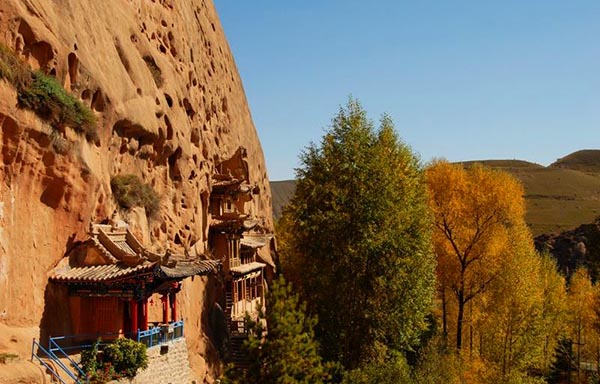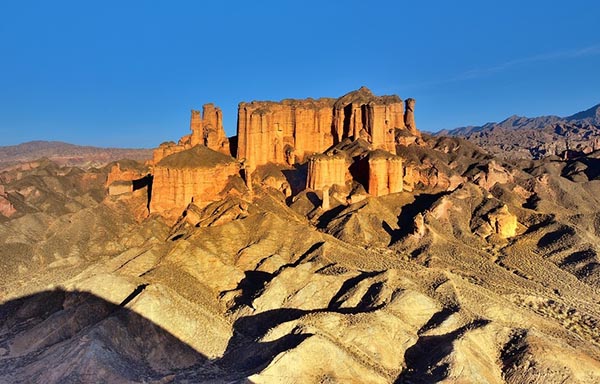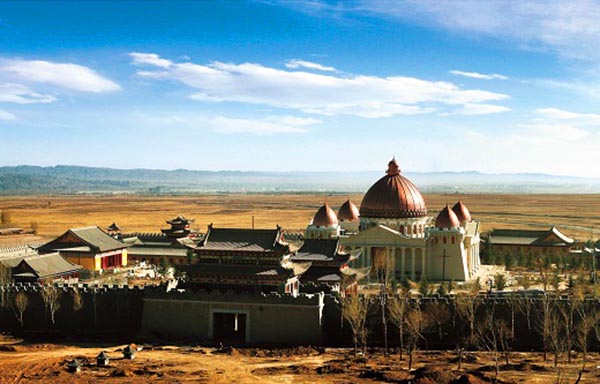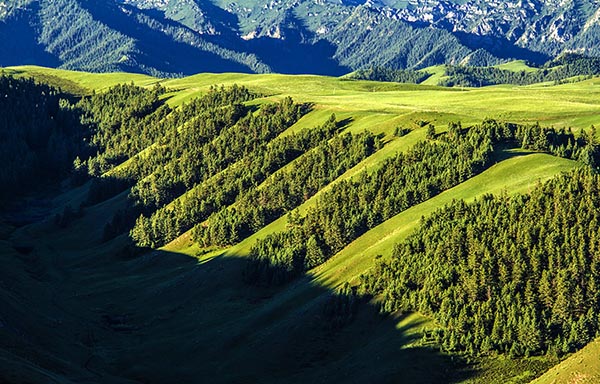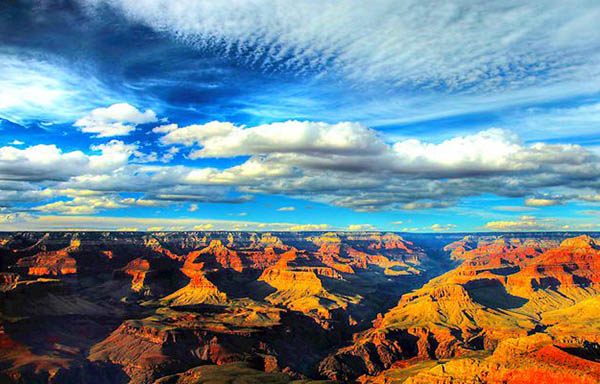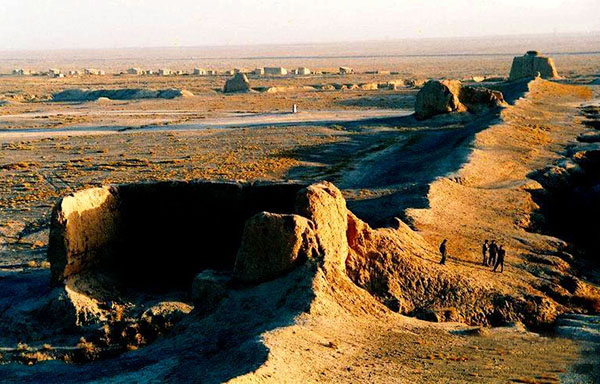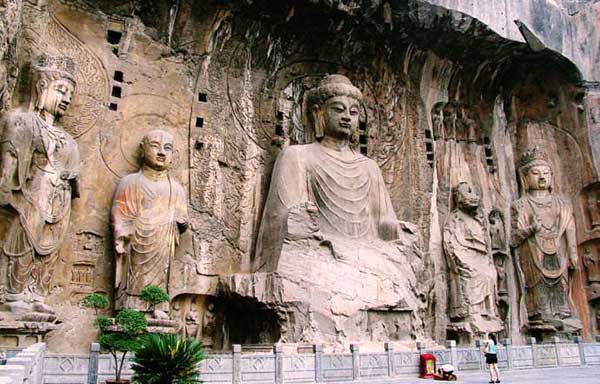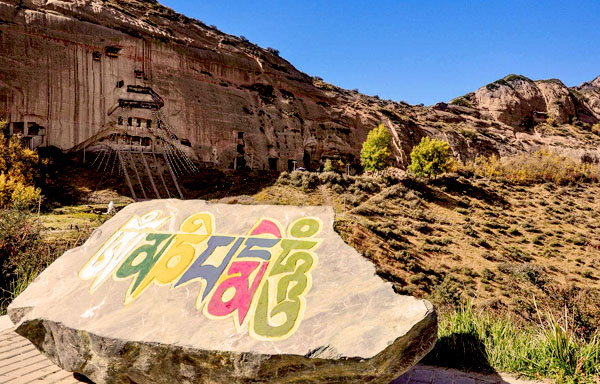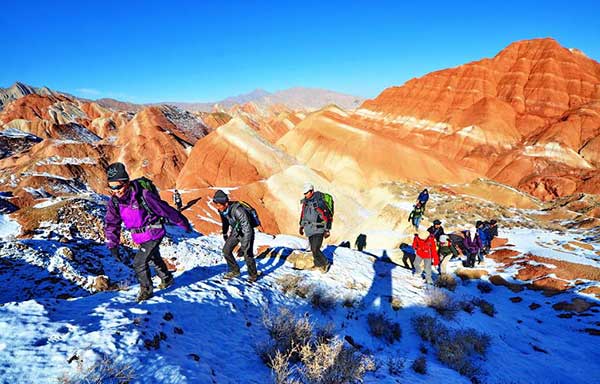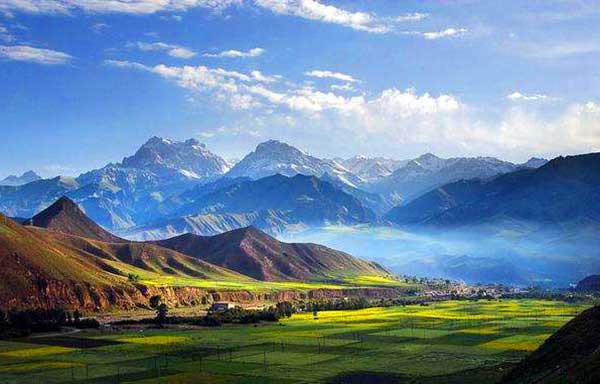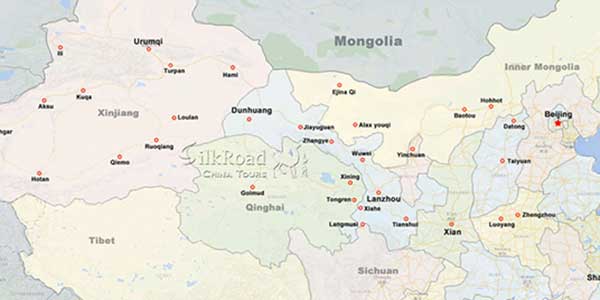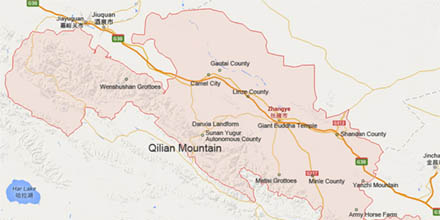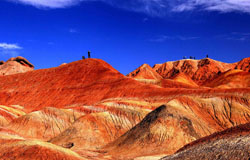 Zhangye Danxia Landform is concentrated predominantly in Linze and Sunan counties in Gansu Province. It is both the largest and the most typical of China's arid area danxia landforms. Because of aridity, the Zhangye Danxia Landform differs from that of south China. It is very dry and desolate, without any vegetation, so geologists call this "window lattice and palace-shaped Danxia topography”.
Zhangye Danxia Landform is concentrated predominantly in Linze and Sunan counties in Gansu Province. It is both the largest and the most typical of China's arid area danxia landforms. Because of aridity, the Zhangye Danxia Landform differs from that of south China. It is very dry and desolate, without any vegetation, so geologists call this "window lattice and palace-shaped Danxia topography”.
Zhangye Danxia Landform is surrounded by colorful hills, which seem to rise and fall like waves: with rock strata of different colors mixed in graceful disarray, it is an imposing and magnificent sight. The Zhangye's palace danxia formations and its colorful hills cover about 300 square kilometers. Its character is unique in China, so it was nominated by the "China National Geographic" as the top 7 Danxia Landforms in the country.
"Danxia Landform" is a broad term used to describe geological formations composed of limestone and conglomerate that have been molded through a series of specific, complex geological processes. These structures are unique to China and are characterized by their deep red hues, steep cliffs, and distinctive shapes.
Unique Characters
Magnificence is the first characteristic of it. Most mountains here are composed of precipitous cliffs, and many cliffs are several hundred meters high, giving people a strong sight shock.
Singularity is the second characteristic. In the region, Danxia cliffs, stone walls, stone pillars, stone peaks, low mountains, hills are widely distributed, as well as stone bridges of various shapes. Some peaks are like “couple peaks”, whispering with each other; some are like Skyscrapers, standing straight to the sky; some other are like palaces, appearing splendid in its momentum.
Risk is the third characteristic. There are high mountains with dramatic ups and downs, and deep valleys with ravines and gullies criss-cross. It is very daunting that many peaks are just like cut by the nature.
In addition, the Danxia landform has gorgeous colors due to the organic sediments. You can see various colors, like red, yellow, orange, green, white, black, gray, etc, making the place so colorful and splendid. In the day, the mountains are like brightly colored silks or colorful gemstones. Besides, with the changes of time and weather, the colors vary constantly, adding the visual shock of tourists.
How Did The Rainbow Mountains Form?
The Rainbow Mountains are cretaceous sandstones and siltstones that were deposited in China before the Himalayan Mountains were formed. The sand and silt was deposited with iron and trace minerals that provided it with the key ingredient to form the colors we see today.
What was once a layered horizontal and flat stratigraphy was disrupted by the Indian Plate colliding into the Eurasian Plate approximately 55 million years ago. Much like when two cars get in a wreck and the bumpers fold and break, a similar process folded what was once flat sandstones into the Rainbow Mountains we see today. This process uplifted mountains and exposed sedimentary rocks that were otherwise hidden well below the surface of the earth. Weathering and erosion removed the overlying layers of continental siliciclastic rocks and exposed underlying formations with different mineralogy and chemistry. This causes the striking variation in colors seen across the Rainbow Mountains.
how they got the color we see today.
Precipitated groundwater moves through the sandstone grains and deposits trace minerals in between the grains. This precipitate can build up to a point where there is no longer an pore space between the individual grains, cementing them in place. This process is what imparts the trace minerals mentioned below and allows for the otherworldly coloring of sandstones around the world.
The primary color is a deep red sandstone, not unlike the Fountain Formation that outcrops in the Flatirons, Red Rocks Park, and the Garden of the Gods all in Colorado. The red coloring is due to an iron oxide coating and cementation, also known as hematite (Fe2O3), between the sandstone grains. This is the exact same process that takes place when a piece of metal is left out in the rain and forms a red layer of rust around the outside.
Weathering, mixed with water and oxygen oxidizes elemental iron into iron oxide, which is notable for its dark red coloring. The Rainbow Mountains are largely characterized by this iron oxide staining of its sandstone Danxia formation.
Most of the time iron oxides impart a dark red pigment, however, there are instances where oxides form different colors. For example oxidized limonite or goethite will produce brown or yellow staining of sandstones, magnetite can form black staining of sandstones. If there is iron sulfide present, you will get a metallic yellow color imparted by the sulfur. Meanwhile, green coloring is often due to chlorite or iron silicate clays. These are just some examples of how sandstones can be altered in coloring during diagenesis.
What to see?
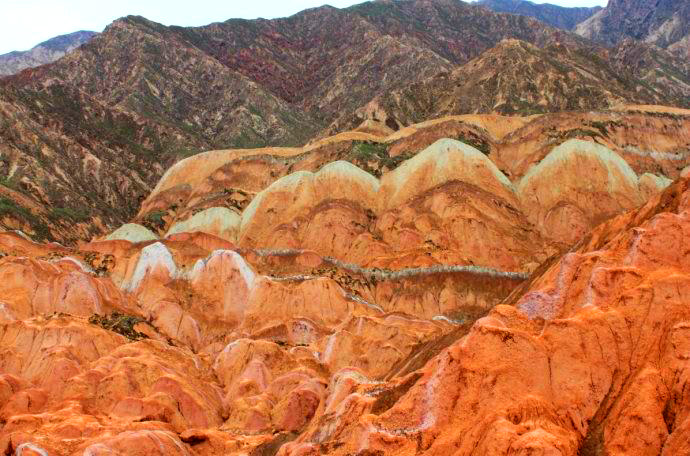 Huge Scallop Rock Cumulus
Huge Scallop Rock Cumulus
These huge "scallops" on the sylphlike mountains as see fairy formed hundreds of millions of years ago are made of red, gray white and yellowish gray stripes of sandstone cumulus, after great transformation and enormous evolution in the nature. Their peculiar shapes bring a joy of life to color hills, and are also like a take-off dragon rising abruptly out of the ground, praying for the people and producing good harvests..
 Monks Worship Buddha
Monks Worship Buddha
The round purple red sandstones formed through the geological change and external force, and this is the picture that devout monks wearing robes carved out after one hundred million years of hard practice and the years of baptism worship on bended kness at the foot of the sleeping Buddha stature on the back.
Gallery
Attractions in the area
Related Tours
General Information
Alias: No
Loc: 50 km from Zhangye
Entrance: 75 RMB
Open Time: 08:00~18:00
Relevant blogs
-
The inaugural flight ceremony of Chengdu Airlines' "Tu
At 17:00 on May 25, a plane loaded with characteristic elements of Turpan in Xinjiang Province landed smoothly at Jiaohe Airport, marking the first flight of C
-
The 2024 Jiayuguan Great Wall Marathon and Great Wall Le
The reporter learned from the press conference held by the Gansu Provincial Government Information Office on May 10 that the 2024 Jiayuguan Great Wall Marathon
-
The "Poetic Dream Dunhuang" presents a magnificent per
"On the evening of May 6, 2024, a large-scale water dance light show titled 'Poetic Dream Dunhuang' was presented at the Danghe River in Dunhuang City, capti
-
Lanzhou cultural tourism new highlights "the Yellow Riv
As night falls, the mountains, towers, Bridges and buildings on the Yellow River in Lanzhou, Gansu Province gradually light up with neon lights, reflecting on
-
Silk Road horses and camels
The people [of Ferghana]...have...many good horses.
The horses sweat blood and come from the stock of the "heavenly horse."
--Zhang Qian, 2nd c. BCE (tr. F. Hir -
Hong Kong-Dunhuang route officially resumed: one round t
A flight carrying 159 passengers from Hong Kong International Airport to Dunhuang Mogao International Airport officially resumed on the afternoon of 22, markin

